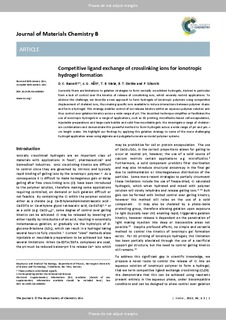Competitive ligand exchange of crosslinking ions for ionotropic hydrogel formation.
Journal article, Peer reviewed
Accepted version
Permanent lenke
http://hdl.handle.net/11250/2452809Utgivelsesdato
2016Metadata
Vis full innførselSamlinger
- Institutt for fysikk [2698]
- Publikasjoner fra CRIStin - NTNU [38278]
Sammendrag
Currently there are limitations to gelation strategies to form ionically crosslinked hydrogels, derived in particular from a lack of control over the release kinetics of crosslinking ions, which severely restrict applications. To address this challenge, we describe a new approach to form hydrogels of ionotropic polymers using competitive displacement of chelated ions, thus making specific ions available to induce interactions between polymer chains and form a hydrogel. This strategy enables control of ion release kinetics within an aqueous polymer solution and thus control over gelation kinetics across a wide range of pH. The described technique simplifies or facilitates the use of ionotropic hydrogels in a range of applications, such as 3D printing, microfluidic-based cell encapsulation, injectable preparations and large scale bubble and solid free mouldable gels. We investigate a range of chelator-ion combinations and demonstrate this powerful method to form hydrogels across a wide range of pH and µm–cm length scales. We highlight our findings by applying this gelation strategy to some of the more challenging hydrogel application areas using alginate and polygalacturonate as model polymer systems.
